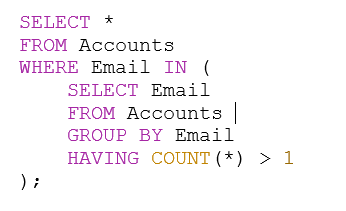SQL Pro Tip: How to Find Duplicate Records
Duplicates in a database can mess up reports—and confuse users—especially when using SQL Server Agent. Manually going through every line and deleting duplicate records is time consuming and prone to errors. Luckily there is a clear, practical solution to clean up duplicate records in a database. Keep this best practice handy to find duplicate records in a table, such as “accounts,” and then easily remove them.
How to Find Duplicates in an SQL Database
Start with this query to spot duplicate records in an SQL Server Agent database, in this example, based on email:
SQL Example

This lists each email that appears more than once, along with how many times it shows up. Found some? Dig deeper with:
SQL Example

Now you see the full rows.
How to Remove Duplicates in an SQL Database
To clean up the duplicates found in your SQL database, keep the latest record (assuming an “ID” column tracks order):
SQL Example

This keeps the highest ID per email and ditches the rest. Test it on a backup before running in production—safety first! This solves the duplicate problem and leaves your data cleaner than ever.
More SQL Server Agent Best Practices
Looking for more SQL Server Agent best practices and pro tips?
- Writing Efficient SQL Queries: Follow these nine tips for writing maintainable and efficient queries for optimal database performance.
- Introduction to SQL Joins: Learn about the different types of basic SQL joins—and how to use them—to efficiently pull results from databases.
- Complex SQL Joins: Unlock deeper insights from your SQL data with these more advanced join types.
Move Beyond SQL Server with Workload Automation
Is SQL Server Agent starting to feel more complex? Learn how a workload automation solution can help you break free from the limits of SQL Server Agent to move beyond time-based scheduling. And discover how to better orchestrate jobs across your entire IT environment with one centralized solution.